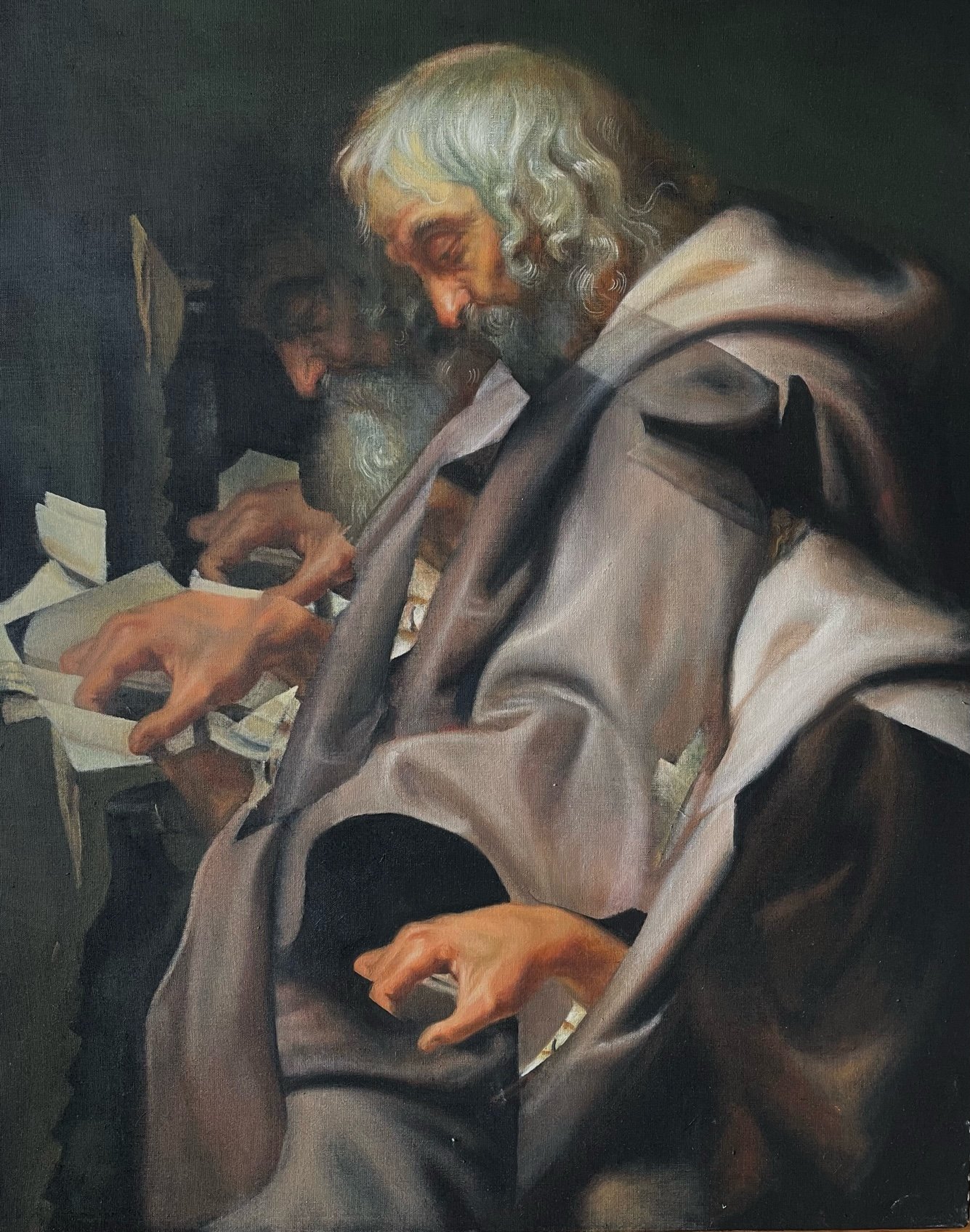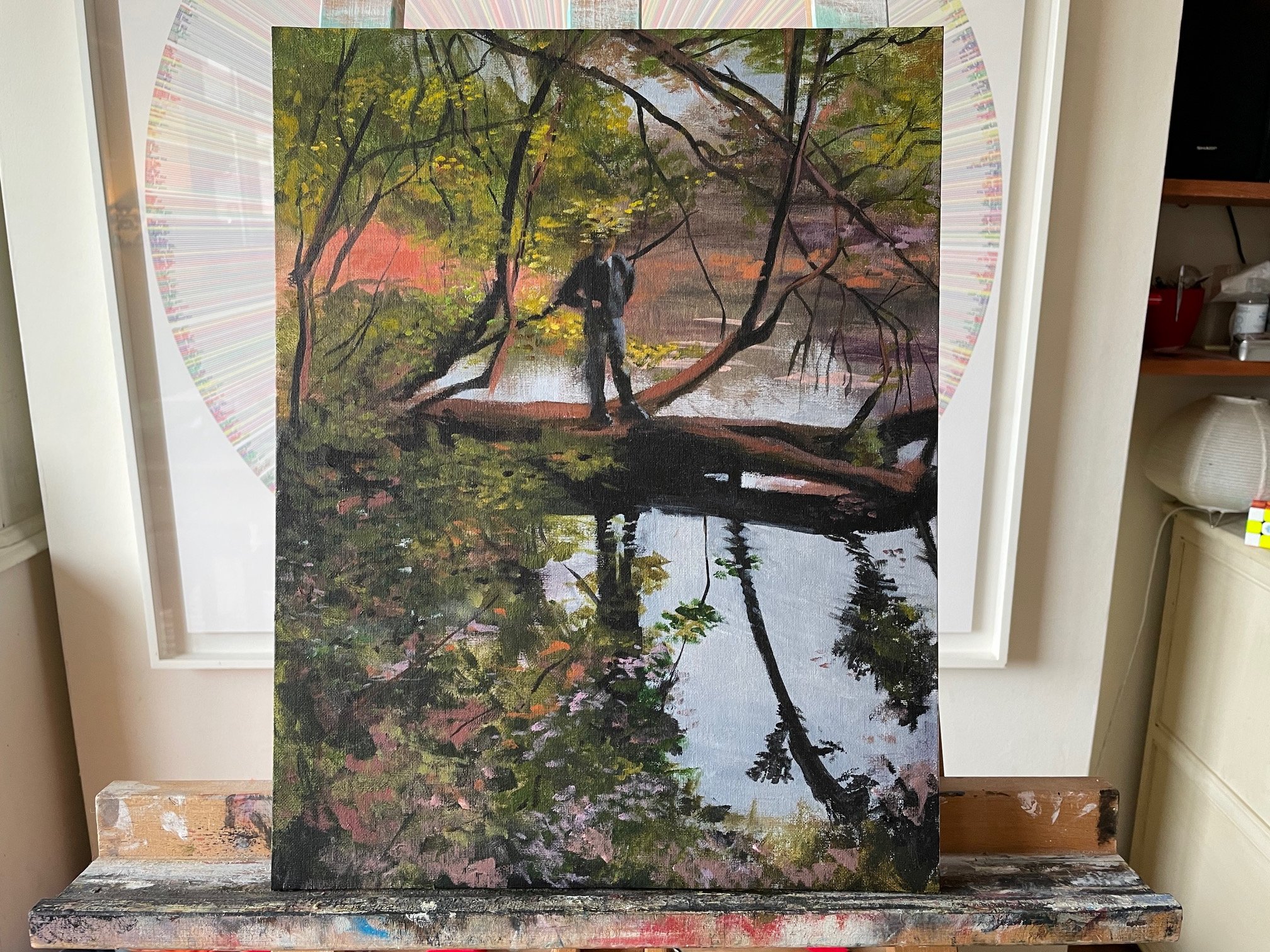ARTIST INTERVIEW: Chris Longridge
Tell me about yourself. What sparked your interest in painting?
I’ve been painting for as long as I can remember. I started with fingerpainting and never looked back! I started painting seriously in my teens, teaching myself to use acrylics, and graduated finally to oils - much later than I needed to - in my 40s. The speed that acrylics dry, however, and the relatively limited pigment range, proved to be a great education, forcing me to be more decisive and creative, which has helped my oil painting.
Why do you feel compelled to paint portraits and figurative works? What is it that fascinates you about the human body?
People are intrinsically interesting to other people. Our brains are wired to look for faces even where there are none, so there’s something inevitably compelling about humans in art. I’m interested in notions that you might call universal problems; mortality, selfhood, imperfect communication - so the human body seems like an appropriate focal point for those kinds of ideas.
As well as working from life, you also work from images. What are the characteristics of an interesting subject to paint?
I know it when I see it, though I rarely know why straight away, especially as my paintings are usually recompositions of prior images. The photo (or painting, sometimes - I also use old master paintings as starting points) is where it always starts, and typically there’s something attractive about the composition; the visible and hidden lines that lead the eye through it, the contrasts of light and colour. There also might be a narrative mystery to explore. Some images have potential and some don’t, but I rely on instinct to tell me which is which. I often don’t know why I’ve been drawn to an image until quite late on in the process.
What are your thoughts on the Charles Dickens quote, ‘There are only two styles of portrait painting; the serious and the smirk’?
Insofar as he was referring to his own era, I’m not sure we can treat it as a useful comment any more. Portraiture means something different in a post-photographic world, and the relationship between artist and sitter changes every century. I would say that there are perhaps two aspects to portraiture, if not two “styles”: the portrait and the painting. The first is about the sitter, the second is about the artist.
How do you approach a painting? What is your creative process?
I start with a digital image that catches my eye, and usually deconstruct it using Photoshop to find new assemblages and put it back together in a way that suits my purposes. Again, on Photoshop. I then paint the result, and often learn more about the final composition as I go along, changing my plans on the fly depending on how courageous I’m feeling.
You have done many self portraits. Have you revealed anything about yourself whilst creating them?
Absolutely nothing, other than that one of my ears is definitely lower than the other. I don’t approach self-portraiture psychologically at all, it’s always an exercise in composition, or lighting, or technique. I do them when I’ve got nothing better to paint and I think I’ve got a starter image (of myself) that might make a good painting. If there’s anything to learn about me from these paintings, it’s not concealed or even inserted, it’s there for anyone to see.
You appeared on Sky Portrait Artist of the Year twice. Describe your experience on the show. How did you adapt your process to comply with the time constraints?
I absolutely loved doing PAOTY - it was a real validation for a self-taught artist, and lots of fun. I made friends each time I went on the show (and gained clients!) and have stayed in touch with many of them - there’s a real Instagram community of us. As for the painting experience, you need to be able to work quickly and unselfconsciously - a confident state of flow is very helpful in that environment. You can aim for a likeness or for a good painting, and if you’re lucky you’ll have something of both in the end result, but what you won’t have is perfection. I didn’t always manage to relax, and floundered badly when I couldn’t. I also found I tend to super-focus my energies to a fault. It’s all very well concentrating for hours on end but you have to remember to step back and look at the whole picture - not just the bit you’re doing, and you have to do it all the time, not every now and then. Each brushstroke should be considered in relation to its adjacent strokes *and* to every other one on the canvas, *and* all the strokes you haven’t made yet, at the same time. I still struggle with that, but a TV recording is an especially unforgiving situation! The crew couldn’t have been more supportive, though - they really seem to love the job and the show.
Who has been your favourite subject to paint, and why?
If I’m honest, Noel Clarke was the best celebrity subject: a really interesting face and physical presence. Shame he later turned out to be a total bellend - you can Google him if you want the unpleasant details. Outside of the show, my son is the person I paint the most, partly because he’s the person I take the most photos of, so he offers more opportunities. I can also look at him for hours and still enjoy it!
If you could have a conversation with any artist, dead or alive, who would it be?
Rubens, Caravaggio and Artemisia Gentileschi interest me a lot. I’d like to talk to them, not just to ask questions, but to get the measure of them as people. Were they kind? Selfish? Egotistical? Curious? Fun? Nerdy? Caravaggio and Gentileschi particularly interest me as a pair: their working years almost overlap, and they have much in common stylistically. Our collective view of Caravaggio is that he was a kind of swaggering pirate, while Gentileschi, to the extent she’s known at all, is remembered as a proto-feminist icon and agent of artistic female vengeance. But I think that reduces both of them terribly. Knowing what they were like would allow us to look at their work from different, wider, more humane perspectives.
Why do you think art is important in society?
You’ve got to imagine it before you can make it happen. Art; creativity in whatever form, is the engine of cultural and social change. It’s what humans do when we’re not merely subsisting. It’s the definition of humanity, in fact: apes and otters alike use tools, and insects have communities, but humans are the only cultural animals.










